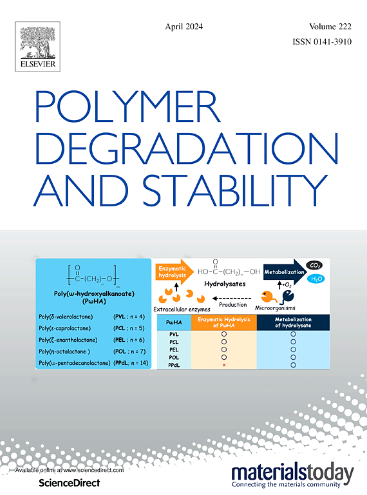Enhancing the recyclability of ELV plastic bumpers: Characterization of molecular, morphological, rheological, mechanical properties and ageing degradation
IF 6.3
2区 化学
Q1 POLYMER SCIENCE
引用次数: 0
Abstract
While the automotive industry has traditionally prioritized metal recycling, the increasing use of plastics in vehicles underlines the need for sustainable management of these materials. Recycling rates of plastics from end-of-life vehicles (ELVs) in Europe are low, but recent EU legislation requires 25 % of the plastics in new vehicles to be recycled, forcing innovative designs and strategies to enhance the recovery and quality of recycled resins. This study focuses on post-consumer bumpers, a significant recoverable component of ELVs, by assessing their molecular, morphological, rheological, and mechanical properties to investigate their homogeneity and quality from various sources to assess their suitability for recycling. Since the aging of these materials, caused by thermo-oxidative and thermo-mechanical degradation processes, can compromise the quality of recycled bumpers, we propose a blend of recycled PP from different bumper cars with virgin resin, representing a realistic scenario where the post-consumer ELV bumpers are collected. Interestingly, this blend, which can replace up to 50 % of the virgin resin without additional compatibilizers or additives, mitigates the degradation effects. Furthermore, the study evaluates the degradation resistance of these blends through multiple extrusion cycles and accelerated weathering tests in a temperature-controlled UV chamber to ascertain the number of cycles the material can tolerate without significant quality degradation, and to determine its suitability for long-term applications. Our results not only support the feasibility of using recycled PP for automotive components but also contribute to meeting the EU's recycling targets. This research highlights the potential for significant advances in the circularity of automotive plastics, providing a sustainable pathway for integrating recycled materials into new vehicle production.
提高 ELV 塑料保险杠的可回收性:分子、形态、流变、机械性能和老化降解的表征
虽然汽车行业传统上将金属回收作为优先事项,但汽车中塑料使用量的不断增加凸显了对这些材料进行可持续管理的必要性。欧洲报废汽车(ELV)中塑料的回收率很低,但最近欧盟立法要求对新车中 25% 的塑料进行回收,这迫使我们采用创新设计和策略来提高回收树脂的回收率和质量。消费后保险杠是 ELV 中的重要可回收成分,本研究将重点放在消费后保险杠上,通过评估其分子、形态、流变学和机械性能,研究其不同来源的均匀性和质量,以评估其是否适合回收利用。由于热氧化和热机械降解过程会导致这些材料的老化,从而影响回收保险杠的质量,因此我们建议将来自不同保险杠车的回收聚丙烯与原生树脂混合,这代表了收集消费后 ELV 保险杠的现实情况。有趣的是,这种混合物无需额外的相容剂或添加剂即可替代高达 50% 的原生树脂,从而减轻了降解效应。此外,这项研究还通过多次挤压循环和温控紫外线室加速老化试验对这些混合物的抗降解性进行了评估,以确定材料在无明显质量退化的情况下可承受的循环次数,并确定其是否适合长期应用。我们的研究结果不仅证明了在汽车部件中使用回收聚丙烯的可行性,还有助于实现欧盟的回收目标。这项研究凸显了在汽车塑料循环性方面取得重大进展的潜力,为将回收材料整合到新车生产中提供了一条可持续发展的途径。
本文章由计算机程序翻译,如有差异,请以英文原文为准。
求助全文
约1分钟内获得全文
求助全文
来源期刊

Polymer Degradation and Stability
化学-高分子科学
CiteScore
10.10
自引率
10.20%
发文量
325
审稿时长
23 days
期刊介绍:
Polymer Degradation and Stability deals with the degradation reactions and their control which are a major preoccupation of practitioners of the many and diverse aspects of modern polymer technology.
Deteriorative reactions occur during processing, when polymers are subjected to heat, oxygen and mechanical stress, and during the useful life of the materials when oxygen and sunlight are the most important degradative agencies. In more specialised applications, degradation may be induced by high energy radiation, ozone, atmospheric pollutants, mechanical stress, biological action, hydrolysis and many other influences. The mechanisms of these reactions and stabilisation processes must be understood if the technology and application of polymers are to continue to advance. The reporting of investigations of this kind is therefore a major function of this journal.
However there are also new developments in polymer technology in which degradation processes find positive applications. For example, photodegradable plastics are now available, the recycling of polymeric products will become increasingly important, degradation and combustion studies are involved in the definition of the fire hazards which are associated with polymeric materials and the microelectronics industry is vitally dependent upon polymer degradation in the manufacture of its circuitry. Polymer properties may also be improved by processes like curing and grafting, the chemistry of which can be closely related to that which causes physical deterioration in other circumstances.
 求助内容:
求助内容: 应助结果提醒方式:
应助结果提醒方式:


